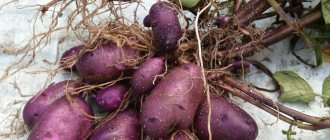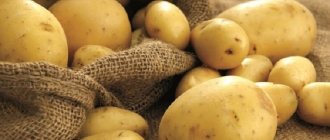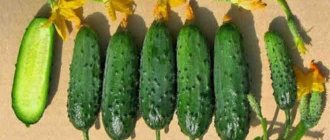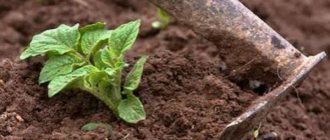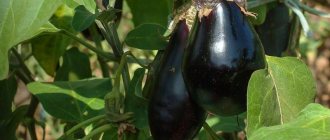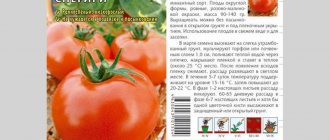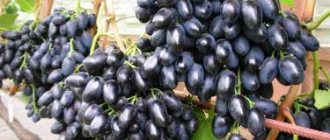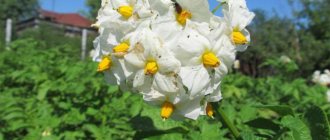Vegetable growing » Potatoes
0
1638
Article rating
Kira Stoletova
Ramona potatoes were introduced in the early 90s. During this time, he proved himself to be excellent. Its taste and external qualities are loved by many vegetable growers. The Ramona potato variety is very popular not only among ordinary people, but also among large enterprises.
Description of Ramona Potatoes
Ramona potatoes: main characteristics and description of the variety
Potatoes of this variety are classified as mid-season varieties - tubers at the stage of technical ripeness can be dug up approximately 3 months after the sprouts appear. The tops begin to wither approximately 4-4.5 months after germination of the planting material.
On a note!
But the ripening time for root tubers of the Ramona variety directly depends on the quality of the planting material, as well as on the weather conditions in the region where Ramona potatoes grow.
The bushes of this potato are spreading, they are quite tall and strong. The tops are erect, with good foliage, up to 0.5-0.7 m high. Bushes form quite quickly.
Photo of Ramona potatoes
The foliage is medium in size, in shape – typical of potatoes, elongated with sharp tips, rich emerald color. The flowers are small, with purple petals with a reddish or light tint. The corollas are medium-sized, purple in color with a reddish tint.
Ramona potato tubers are light pink in color, their shape is oval-round, they can be medium or large in size.
The average weight of Ramona variety tubers is 80-85 g
. From each bush you can collect up to 17-20 potatoes, with their marketable yield being about 92-93%.
The peel is compacted and very strong, has a light red tint. If there is little rainfall during the season, the color of the skin will be lighter. Small eyes are buried in the tubers to an average size, their total number is small. The pulp is compacted, white with a creamy tint.
The best potato varieties for the middle zone!
11 best potato varieties for the middle zone
According to its purpose, the Ramona potato variety is classified as a table potato. Its pulp is crumbly and does not darken during baking, boiling or frying. The harvested crop is versatile.
On a note!
The tasting rating for the taste of Ramona potatoes is 4.7 points out of 5 possible. Product yield is up to 95%.
The dry matter content of tubers of this variety is 17-18%.
The harvested crop can be stored in appropriate conditions for a long time - almost until the end of spring. At the same time, it germinates poorly. Typically, no more than 8 sprouts can form on each tuber.
Tubers are resistant to damage during harvesting, transportation over any distance and during storage.
Description and characteristics
The Ramona variety was bred in the early 90s of the twentieth century. And already in 1994 it was included in the State Register of the Russian Federation. The originator of the variety is the Agrico company, registered in Holland.
Ramona bushes are quite tall, erect, with an abundance of green mass. The bush grows quickly; during the flowering period, flowers of red and lilac shades are formed. One bush brings up to 16-20 tubers with a total weight of 7.5-9 kg.
You should look in more detail at the description of the tubers:
- the tubers are pink in color, oval or round in shape;
- size - medium and large;
- weight of one tuber - 75-90 g;
- the pulp has a creamy color and a fairly dense structure;
- dry matter content - 16-18%;
- starch - 14-17%.
Taste qualities
Experts rate the taste qualities of this variety at 4.6-4.7 (maximum number of points - 5). After cooking, it does not darken (regardless of the heat treatment method), and boils well. Can be used to prepare all possible dishes that include potatoes.
Important! One of the characteristic features of the Ramona variety is its tendency to degenerate. This circumstance requires periodic renewal of planting material.
Ripening time and yield
Ramona is a mid-season variety, its growing season is 80-100 days. Starting from about 120-125 days, the stage of withering of the tops begins. The average yield is approximately 10-15 tons per hectare, however, under certain favorable conditions, including weather, and using modern agrotechnical techniques and fertilizing, you can get a yield of 25-30 t/ha.
Ramona potato yield
The yield of this variety is stable and guaranteed even in dry periods.
Since on average up to 20 potatoes are harvested from each bush, in total each bush can produce up to 8 kg of ripe tubers. And when grown on an industrial scale, on average about 12-15 tons are collected from 1 hectare.
Cross-sectional photo of Ramona potatoes
During the period of varietal testing, the potato variety showed a fairly high yield - from 11 to 32 tons per hectare, and the maximum indicator was 34.
Cultivation care
We recommend reading our other articles
- Grape variety Izyuminka
- Lada pear variety
- Grape variety Zabava
- Description of the Ethiopian melon variety
Hilling potatoes photo
The same amount of time is spent caring for Rodrigo potatoes as any other variety. With proper attention, the harvest should last throughout the winter, and for sale!
- Watering is carried out rarely, abundantly. During the season, you can simply water the potatoes well three times, this will be enough even in a dry summer.
- Weeds are removed as they appear; this procedure can be combined with loosening the rows, hilling or watering.
- If a gardener wants to use herbicides to get rid of weeds on potato plantings, then it is better to do this before sprouts appear, since Rodrigo potatoes do not like such chemicals and can slow down growth.
- In order for the tubers to grow strong, it is worth watering the bushes at the root with calcium nitrate. You need about 2 waterings per season, but you can get by with just one.
- Rodrigo potatoes are resistant to cancer, nematode, scab, and late blight, but sometimes they can still get sick, so preventive treatments will not hurt.
- Preventative treatment is carried out against pests if there are none. The Colorado potato beetle is collected manually or the plantings are sprayed with a suitable insecticide “Aktara”, “Tabu”, “Molniya”, “Commander”.
Harvesting is usually done in 2 stages. Some potatoes are harvested young, and the rest of the crop is harvested when it reaches final ripeness. Before harvesting, the bushes are cut off - only the stumps are left. The potatoes are dug up and laid out to dry. Store dried potatoes after digging in a dry, dark room with a temperature of about +3 degrees Celsius. To ensure high safety, it is better to sort the tubers before storing them for the winter.
Diseases and pests
It should be noted that potatoes of this variety are highly resistant to the following diseases:
- potato cancer;
- virus A, Yn;
- twisting of the tops.
Pests in the garden!
How to deal with the cutworm How to deal with the mole cricket
Resistance to late blight and fusarium in Ramona potatoes is average. This variety is characterized by low resistance to leaf roll virus, as well as to common scab, and is characterized by susceptibility to golden potato nematode.
One of the obvious advantages of this variety is its resistance to attacks by the Colorado potato beetle and its larvae, so vegetable growers do not have to take numerous protective measures against these pests.
Planting potatoes
Planting potatoes includes:
- preparation of seed material;
- pre-sowing soil preparation;
- landing.
Seed material needs to be prepared. Tubers sprout on their own or are sprouted. To increase the amount of material, potatoes can be cut into several parts. In this case, keep in mind that the more eyes there are on the potato, the more sprouts there will be and the stronger the bush will be. This will ensure a high level of productivity.
Did you know? Red-skinned varieties are always more shelf-stable. But cream-colored varieties have excellent taste, but are stored much worse.
The soil is dug up and fertilizers are applied. Root crops need loose soil for good root system development. And since tubers are thickened roots, the absence of stones or large clods of earth in the soil will help to get them even and without deformation.
Potatoes tolerate cool weather well - from +7 to +13 °C, so planting is carried out when the air temperature reaches these levels. Perhaps it will be March. You can continue planting until the third decade of April. Be sure to take into account that spring frosts should end by this time. Lasunok is not declared as a frost-resistant variety and may die due to frost and wet, cold soil.
Soil requirements
The potato root system develops better in loose soils. If the area is clayey and there is no way to change the structure, then be sure to carefully dig and loosen it. To enhance looseness, add sand, peat or other bulk materials.
A tuber is a thickening of the root, a kind of storehouse of nutrients, so the development of potatoes depends on the nutritional value of the soil. Fertilizing can be organic - compost, rotted manure, leaf soil, etc. or inorganic - from store-bought fertilizers. Plants definitely need nitrogen, phosphorus and potassium fertilizers.
Did you know? Mid-season and late-ripening potatoes are more suitable for storage than early varieties. They have thicker skin and are highly resistant to fungal diseases and rot.
The required acidity level is 5.5 to 7 pH. If the soil is more acidic, add dolomite flour, lime or chalk to deoxidize. In acidic soil, plants become weak and yields are low, and the incidence of potato rot increases. The deacidifying agent should be applied 1–2 weeks before planting.
For lime, the application rate will be as follows (g/sq. m):
- slightly acidic soil reaction - 300 g;
- medium sour - 400 g;
- acidic soil - 500 g.
Disinfection begins in the fall by deep digging. This way you reduce the number of overwintering pests by raising them closer to the freezing point.
Preparation of planting material
Planting material is prepared in February. Sprout whole tubers or divide them into parts. Each piece should have at least 2-3 eyes, but it is better if there are 4-5. This strengthens your bush and increases your yield.
To prevent infection of the tuber by phytopathogens, the cut sites are treated with ash and dried for 2–3 days. The room temperature should be about +14°C, and the air humidity should be about 80–90%. Germination takes 2–3 weeks, so if you plan to plant at the end of March, start germination at the beginning of the month.
Important! If the tubers are exposed to direct sunlight for some time, a plant poison, solanine, accumulates in the peel. It is dangerous for both people and animals. It will cause intestinal upset in humans, but may kill a pet
It will cause intestinal upset in humans, but may kill a pet.
Landing technology
Planting consists of preparing a planting site (a hole or trench), applying fertilizer and placing seed material.
Landing instructions:
- Dig a trench about 0.2–0.3 m deep. The bottom of the trench should consist of sufficiently loose soil.
- Potatoes are placed on it with a distance of 25–40 cm between them. The greater the distance between individual trenches, the smaller the distance between tubers. Normally it is 0.4–0.5 m.
- The tubers are covered with soil mixed with fertilizers. For rotted manure, the norm is 2–3 buckets per 1 square meter. m of soil. Manure provides tubers with potassium, which is necessary for the formation of starch.
- Add 300 g of urea to the mixture to provide the tubers with sufficient nitrogen.
- Cover the trench with regular soil.
If some of the soil does not fit into the trench, then it is left next to it in order to carry out hilling. 2 weeks after planting, loosening, first hilling and covering of the plantings with mulch material are carried out.
Positive characteristics and disadvantages
The main advantages of the Ramona potato variety include:
- good appearance of root crops;
- all tubers are approximately the same size;
- the Ramona variety is unpretentious to the composition of the soil;
- bushes of this potato tolerate periods of drought well;
- in the southern regions you can harvest two harvests of Ramona potatoes per season;
- the versatility of the harvested crop, which can be used to prepare chips, French fries or semi-finished products.
Experts include the following relative disadvantages of the Ramona variety:
- not too rapid formation of tubers in the initial stage;
- the quantity of marketable products at the output has an average value.
Characteristics of the variety
Raymond potatoes (also called Romano or Ramona) are mid-early varieties. The ripening period for potatoes is 2.5 months.
Potato Ramona
The climate of the southern regions of Russia and Ukraine allows you to harvest twice in 1 year.
Description of Ramona Potatoes:
- The peel is smooth and thick, pink in color;
- Tubers are elongated or round with a smooth surface;
- The pulp is light with a yellow undertone;
- The eyes are small, go deep inside the tuber;
- The average starch content is 15%, which is high, which means that the potatoes boil well during the cooking process;
- The tubers are of average size, with a maximum weight of 90 g.
Variety characteristics:
- Highest marketability rate - 94%;
- The tops are powerful, the trunk is tall and straight, the inflorescences are small and purple;
- Potato yield from 1 bush – 9 pcs., total weight – up to 800 g;
- Productivity, depending on the soil and planting region, ranges from 110-340 c/ha;
- Does not germinate during prolonged storage.
Ramona potatoes: planting and further cultivation
The procedure for planting Ramona potatoes is not much different from planting planting material of other varieties. But some nuances will be discussed below.
First of all, you need to remember that planting material degenerates after about 4 seasons, so care should be taken in advance to renew varietal tubers.
To do this, a couple of seasons before the proposed planting of new varietal potatoes, it is necessary to mark the potato bushes with the largest tubers.
Seeds are collected from these bushes, which are planted in separate, specially prepared beds the following season. After harvesting the tubers, they are stored separately from the main crop.
Planting potatoes Method of planting potatoes to obtain a high yield From A to Z - video
Next season, these tubers are again planted in separate beds, the harvest from which will become new varietal potatoes, which will renew the degenerating tubers of the old harvest.
Ramona potato tubers intended for planting are taken out of the cellar in advance so that they have time to germinate. This is usually done 1 month before the intended planting of planting material in open ground.
Important!
Root tubers are sorted out, removing damaged, lethargic or with traces of disease. Good planting material is placed in a sunny place, where they must be kept for at least 10 hours every day. In this case, the air humidity should be at least 85%.
Large tubers can be cut into pieces, each of which should have at least 2 sprouts, but usually whole medium-sized potatoes are selected for planting. When the sprouts reach a size of 1.0 cm, Ramona tubers can be planted in a permanent place.
Before planting, planting material should be treated with wood ash and any growth stimulant.
The timing of planting Ramona seed potatoes in open ground depends on weather conditions in the planting region. Usually they focus on warming up the soil - it should warm up to a temperature of 8 degrees Celsius at a depth of 12 cm.
Landing dates!
In the southern regions, Ramona potatoes can be planted in March, and in regions with colder climates, the planting dates are shifted to the second half of May. You can also focus on the air temperature - during the day it should be at least +15 degrees Celsius, and at night - at least +5 degrees Celsius.
After planting, Ramona potato tubers are not afraid of spring return frosts, as they can withstand cold snaps down to -4 degrees Celsius.
GOOD POTATO VARIETIES!
Spring Potatoes Colombo Potatoes Rocco Potatoes
When choosing a site for planting this potato, you should remember the rules of crop rotation.
The best predecessors for potatoes are legumes, early varieties of cabbage, cucumbers and green manure.
. You can also grow it after any root vegetables, all varieties of cabbage, green crops, onions, and garlic.
Any plant from the nightshade family - tomatoes, bell peppers and eggplants - will be bad predecessors for potatoes. Potatoes can only be planted in one place after 3 seasons.
It is best to grow potatoes of this variety on light sandy loam soils, which are loose and fertile. But loam is also quite suitable. The acidity of this soil should be neutral
– on acidic or alkaline soils, Ramona potatoes develop poorly and its yield will be extremely low.
If the soil on the site is too acidic, then it is improved in the fall by adding lime or dolomite flour.
The area for planting Ramona potatoes should be prepared in the fall, adding about 6 kg of humus for each square of area for digging.
And immediately before planting, during spring digging, mineral fertilizers are added to the soil:
2 tbsp.
l. superphosphate, 1 tbsp. l. potassium sulfate and 1 cup of wood ash. These dosages are indicated for one square area of the site. Landing rules!
The planting pattern for Ramona tubers is 0.4 m between adjacent holes. The row spacing should be 0.65 m. In heavy soil, planting material is buried to a depth of 7-8 cm, in sandy and sandy loam soils - to 9-10 cm.
It is best to plant potatoes in rows, the direction of which should be from west to east - this will allow the plants to receive more sunlight. Planting material should be “clean”, not subject to cross-pollination, and the mass of tubers should be about 70-75 g.
Onion or garlic peels should be placed at the bottom of the holes, which will “drive away” wireworms and many other “harmful bugs.”
Correct fit
How to plant planting material correctly:
- Tubers must be germinated before planting. They are laid out in a bright, warm place for a period of 3 to 4 weeks. All planting material should receive uniform lighting for at least 8 hours a day. In the room you need to maintain optimal humidity from 85 to 90%;
REFERENCE: Cut large tubers into pieces using a sharp knife, which is moistened in a strong solution of potassium permanganate the day before planting.
- Give preference to planting material whose sprouts are 0.5-1.0 cm;
- The tubers are planted in soil heated to +15-+20 ºС. The distance between the bushes is 35 cm, the row spacing is at least 60 cm. Whole planting material is arranged at the top with sprouts, cut ones are cut down;
- To improve the agrophysical properties of heavy, clayey soils during the autumn digging period, it is necessary to add river sand and wood ash to the soil. During repeated digging in the spring, add amophoska or ammonium nitrate, urea;
- In loamy, heavy soil, tubers are buried to a depth of 6-8 cm. On sandy loam and sandy soils, planted to a depth of 8 to 10 cm. A planting depth of up to 12-15 cm will prevent the planting material from drying out in arid regions;
- Placing a handful of onion and garlic peels in each hole is a preventive measure against potato nematodes, as well as against attacks by wireworm larvae and May beetles.
Further care for Ramona potatoes in open ground
In a normal summer season, it is enough to water the potato beds no more than three times. For the first time, potato bushes are watered when the height of their tops reaches 8-10 cm.
The next watering is carried out during the flowering period and promotes the active formation of tubers. The last watering is carried out after all the bushes have flowered.
Potato care - video
Advice!
In hot and dry weather, water the potatoes once every 7-10 days, adding water between the rows.
Potato beds should be loosened periodically, removing all weeds at the same time. In total, at least 5 loosening should be carried out per season.
Hilling is a mandatory procedure when growing any varieties of potatoes.
. The Ramona potato variety needs to be hilled three times per season.
Step-by-step instructions for growing
Inventory
For high-quality planting and further cultivation use:
- bayonet shovels or large pitchforks (for large areas - mini-tractors, potato planters, diggers);
- bags, nets or boxes - for harvesting vegetables;
- hoes, rakes, rippers - for cleaning areas, caring for bushes;
- watering cans, hoses, drip irrigation systems - for watering;
- tarpaulins, oilcloths, covering materials - for preparing vegetables for storage.
When planting, caring for crops, harvesting potatoes, storing in cellars or pantries, it is recommended to use fabric gloves.
Preparation
Soils
The soil is prepared in the fall. Be sure to do a deep digging. The planting site is selected taking into account crop rotation. Productivity increases in the beds after :
- herbal crops;
- grains, including winter ones;
- legumes;
- rapeseed;
- flax;
- zucchini;
- white mustard;
- pumpkin
Do not use areas where nightshade crops, such as tomatoes, were harvested.
The variety is responsive to nitrogenous soil. To improve heavy and loamy soils, sand and wood ash are added when digging in the fall, and in the spring they are fertilized with ammophos or urea (10 g per 1 square meter of area).
Read also: Grated potato dishes recipes
Groundwater should not lie close to the planting areas, but if this cannot be avoided, then the variety is recommended to be planted in ridges, which are placed according to technology from east to west. In this case, the potatoes will receive more necessary sunlight, soil aeration will improve, and the likelihood of fungal damage will decrease. In the spring, the beds are cleaned, dug up, and the soil is leveled with a rake, breaking up large clods. Shortly before planting, during drought, it is worth irrigating the area.
Planting material
About a month before the start of sowing, the tubers need to be germinated . They are laid out in a bright room at a temperature of +14 degrees. Humidity should be 90%. Planting material is treated with growth stimulants, wood ash and minerals.
Potatoes for sowing are calibrated. It is recommended to use tubers weighing 80 g. The sprouts of planting potatoes should be 0.5–1 cm in size. Large vegetables are cut the day before planting with a knife treated in a solution of potassium permanganate.
Boarding time
The main condition for starting to plant the Ramona variety in the beds is soil heated from +16 to +20 degrees.
In the southern regions, work begins in late April - early May. In the Moscow region - from mid-May. In the Urals and Siberia - from late spring or early June. The timing will depend on weather conditions.
Planting scheme
The depth of planting tubers in loamy and heavy soils is from 6 to 8 cm. In sandy loam and sandy beds - from 8 to 10 cm. Indentations of 35 cm are made between potato bushes. The distance between rows should be 60 cm. Whole tubers are laid out in sprouts up, and cut potatoes - cut side down.
Hilling
Adding moist soil helps strengthen potato roots, protect them from cold, and increase productivity and immunity. It is recommended to do the procedure two to three times throughout the entire season. The first time is earthed up after the sprouts reach 10 cm, the second time during budding, the third time during flowering. On small-sized beds, you can use a hoe , hill up the bushes manually, on large sown areas it is better to use a walk-behind tractor.
Watering
The variety's tubers form well even with little soil moisture. Irrigation is carried out as needed. During drought, the inter-row spaces are watered once every 7-10 days.
Loosening
During the entire growing season, the Ramona potato variety requires 5 loosenings. It is recommended to carefully treat the soil with a hoe even before germination.
Loosening is done after each watering to prevent the formation of a hard crust, which impedes the growth of crops.
Weeding
The beds are cleared of weeds as needed. The first weeding is done 5–7 days after the shoots appear. The procedure is necessary as a preventive measure against potato pests and diseases.
Top dressing
To improve the quality of varietal products during flowering and ripening of tubers, crops are fed with nitrogen and organic nutrients. During the budding period, the bushes are sprayed with a solution of copper sulfate (concentration 0.05%), the substance can be replaced with a solution of zinc sulfate or boric acid. As a result of such fertilizing, the yield of the variety increases by 8–10%.
Other measures
To retain moisture between rows during the dry season, professional gardeners advise using mulching. Covering with peat, straw, and grass will not only reduce the cost of irrigating the site, but will also protect the plantings from sudden cold weather and abundant weeds.
How to feed Ramona potatoes to get a better harvest
During the flowering period, it is recommended to feed these potatoes with nitrogen-containing fertilizers.
And during the period of ovary formation, it is recommended to treat the tops with a solution containing one of the following preparations:
- copper sulfate;
- zinc;
- boric acid.
The best early potato varieties!
The best early varieties of potatoes
You can use chicken manure diluted with water in a ratio of 1:20 as a top dressing for Ramona potatoes, after leaving it in a warm place for 5 days.
After the budding period, ash and potassium sulfate are added under the potato bushes. To do this, mix 30 g of ash and 25 g of potassium sulfate. Sprinkle the potato beds with this mixture. The specified amount of mixture is sufficient for one square area.
Which varieties are considered the earliest in the Russian Federation, depending on the region
Qualitative indicators (yield, starchiness, tuber size, ripening time) depend on weather conditions, soil type and can vary for the same type of vegetable. Thus, Resource grown in the Moscow region contains 11-12% of dry matter, in the Lipetsk region - up to 16%.
For the Middle Band
The regions experience snowy, moderately frosty winters and fairly humid summers with an average temperature of 17-21°C.
Early and ultra-early potato varieties for Central Russia:
Pinkish tubers of the Zhukovsky early variety
For the Moscow region
It is the cyclones and anticyclones that determine what the climate in the Moscow region will be like in the summer. Typically, the amount of warm days and rainfall is sufficient to grow potatoes.
Early potato varieties for the Moscow region:
| Name | Productivity | Consumer properties | Disease resistance |
| Anosta | At the level of 250-300 c/ha. The tubers are regular in shape and medium in size. | Globular tubers with yellow skin and light yellow flesh. The eyes are superficial. Wonderful taste. Starch content - 14-16%. Convenient for cooking chips and French fries. | Does not suffer from nematode disease, leaf curl, or common scab. |
| Bemonda | Maximum yield - 210 c/ha. Tubers are small, 60-76 g. Not in good condition - 4-11%. | Oval red fruit with pale yellow flesh. The eyes are medium. Pleasant taste. Starch content - 10.5-13.5%. | Protected at the genetic level from potato nematodes and late blight on tubers. Shows average resistance to viruses. Susceptible to late blight on leaves. |
| Skoroplodny | With early digging - 15 t/ha. On time - 26-35 t/ha. Potato weight - 60-120 g. | Heat and drought resistant. A very early white variety that does not darken when cut and cooked. | Rarely suffers from late blight and common scab. |
| Pogarsky | 35-45 t/ha. High marketability of tubers. | Starch content - 11-16%. | Has a protective gene against severe forms of viral diseases. |
| Luck | After 2 months - 12-15 t/ha, with mass harvesting - 35-50 t. Potato weight - 120-150 g. | Light beige tubers with small eyes and white flesh. Commercial appearance of tubers - 96-100%. When potassium chloride is added to the soil, the fruits may darken. | Resistant to late blight on leaves and tubers, viruses, scab, and rhizoctonia. Sensitive to Alternaria. |
The Udacha variety is valued for its high yield and resistance to late blight.
For North-Western regions
Late, late spring. Summer is moderately warm, rainy, with an average temperature of +15..+20°C. The total number of sunny days is insignificant. In such conditions, residents of the North-West can only grow early varieties.
The State Register recommends the following for planting in the region:
| Name | Productivity | Appearance and benefits | Disease resistance |
| Felox | At the level of 350-550 c/ha. Tubers are leveled. Not in good condition - 2%. Weight - 90-115 g. | Elongated tubers with yellow skin and pale yellow flesh. The eyes are few in number. Great taste. Starch content - 16-17%. | Nematode resistant. |
| Timo | Maximum variety - 380 c/ha. Tubers are medium-large, 65-120 g. Not in good condition - 10-30%. | Oval fruit with pale yellow flesh. Pleasant taste. Starch content - 14%. | Cancer resistant. Shows average resistance to viruses, late blight, and scab. |
| Karatop | 270-340 c/ha. Potato weight - 60-110 g. | Round tubers with yellow skin. Keeping quality and taste are good. | Resistant to cancer, nematodes, viruses. Relatively to late blight (for early varieties). |
There are many potato varieties with fast ripening times for the Russian climate. Rapid ripening has a number of advantages: early harvest, harvesting before the peak of late blight, good taste, high percentage of marketable tubers.
Ramona potatoes: reviews from those who grew them
Olga, 45 years old, Volgograd region: I have been growing this variety on my plot for more than 10 years. Ramona potatoes are a fairly productive variety, do not require special care, and the harvested crop has an excellent taste and presentation, and can be transported over any distance. Tubers of this variety are stored in the cellar almost until spring. I recommend this variety to all vegetable growers.
Natalya, 55 years old, Saratov region: We grow potatoes for further sale, but we also keep part of the harvest for our own needs. In recent years, I have occupied most of the beds for Ramona potatoes, since they are distinguished by their beautiful presentation and good taste of root crops, as well as the possibility of their long-term storage. As a result, we sell part of the harvest in the fall, and sell part gradually during the winter.
Judging by the main advantages, Ramona potatoes are a very successful variety. Its root vegetables have a good taste and excellent presentation.
The harvested crop tolerates transportation well over different distances and can be stored for a long time in appropriate conditions. The yield of the variety can be increased by adding sufficient fertilizer to the beds.
Romano potatoes
Romano potatoes appeared on our tables thanks to Dutch breeders. He appeared in the State Register of the Russian Federation in 1994 and is a true veteran. After all, many varieties, such as Rocco, got there after 2000. But, nevertheless, despite the abundance of new varieties, the old Romano is still in great demand among the population.
Tips for Growing Romano
After reading the reviews of many agronomists, you can understand that the variety, at least a little, requires some care. In order to get maximum yield, you must follow a number of rules, including:
- Planting tubers in warm soil. For rapid germination and development of potato shoots, it is necessary that the soil temperature is not lower than 15 degrees Celsius. The higher the soil temperature, the sooner the fruit will germinate.
- If the root crop is divided, this should be done immediately before planting. You should not divide potatoes several days before starting work. Before dividing, it is imperative to moisten the knife in a solution of potassium permanganate. This must be done to reduce the risk of tubers becoming infected with a viral disease.
- If you have small planting tubers, then you should not throw them away. For the Rocco variety there is no concept of bad planting material. In this case, small tubers can give an excellent harvest, which will be no worse than when planting medium-sized potatoes.
- If harvesting is taking place, future planting material should be immediately selected. It is chosen not by its tubers, but by its shoots. Potatoes whose tops had the healthiest structure will be used for planting. To avoid making a mistake with your choice, you can initially mark the largest and strongest tops at the peak of their maturity. Let us repeat, the size of the tubers is not important. If in a hole with good tops there are 2-3 small potatoes, then they, just like large ones, will be used as planting material.
Advantages and disadvantages
Romano potatoes have a number of benefits. Among them:
- Excellent taste.
- Good presentation, thanks to which the potatoes are well sold on the market.
- Low defect rate.
- Excellent yield indicators.
- Long shelf life.
- Not afraid of transportation over long distances.
- Tolerates heat well.
- Has fairly high immunity.
It also has disadvantages. In particular, these include:
- Quite a dense shell. On the one hand, it protects the tuber from damage, on the other hand, it prevents convenient cleaning.
- Instability to low temperatures.
- Weak resistance to nematodes and scab.
Features of cultivation
Ramona potatoes produce a stable harvest, regardless of the growing region.
The planting time depends on weather conditions. It is important that the soil is warmed up; the ideal temperature for planting is 15-20˚C. In the southern regions, planting begins in mid-April, and in Moscow and the region, planting begins at the end of May - beginning of June.
Before landing, the following conditions must be met:
- Varieties bred in the Netherlands are highly degenerate. Therefore, it is necessary to periodically update the planting material and use high-quality potatoes for planting. Potatoes weighing 80 g can be used as seed; smaller tubers should be planted 2 pieces per hole;
- Germination of the material must be done 1 month before planting;
- Site selection and soil preparation. The site should be well lit, with deep groundwater. If the groundwater is close to the surface, then potatoes should be planted in ridges 40 cm high. The soil should be loose.
Care includes watering, loosening and fertilizing. Watering is very important during the phase of active growth and development of the plant. Potatoes need to be watered three times: after sprouting, during flowering and 2 weeks after mass flowering. The next day after watering, you need to loosen the soil, remove weeds and feed the plant. Hilling is usually carried out twice. The first time is when the tops reach a height of 10 cm, the second time - after 2 weeks.
To increase yield, you need to mow the tops a week before harvesting so that they do not take away nutrients.
Peculiarities
This variety is notable for being suitable for planting in almost any type of soil. The exception is soils containing a large number of mechanical elements; in their environment it will need additional feeding and care.
The downside is the high dependence on water. Therefore, if you want to get a large and early harvest, then installing an automatic irrigation system would be a good solution.
Due to the characteristics of its fruits, it is perfect for both cooking at home and for growing for industrial purposes. Under the influence of heat treatment, it cooks perfectly and does not lose its pleasant color. Karatop is perfect not only for making regular purees, but also for making chips, and even for freezing.
Before planting, in order to achieve the best yield results, it is recommended to carefully select planting material (you should select only the largest tubers without any damage). It is also best to initially grow the plant in peat pots.
When planting material in the soil, it is better to place tubers of early-ripening varieties closer to each other. To feed Karatop, you should use those fertilizers that are well and quickly absorbed.
The reason for this is that all early-ripening potato varieties absorb nutrients much faster than their late-ripening counterparts.
IMPORTANT! During the ripening period, your plant will process beneficial minerals at double the rate, so during this time it will need additional watering and care. Karatop is one of the latest varieties bred by German agronomists
Cultivated in temperate climate zones, often grown in Russia, Moldova and Ukraine
Karatop is one of the latest varieties bred by German agronomists. Cultivated in temperate climate zones, it is often grown in Russia, Moldova and Ukraine.
The main features of the variety are:
- Precocity. The variety is considered early ripening, the vegetative period of which is 60-65 days. But, on the 50th day after planting, you can begin harvesting.
- Productivity. Karatop produces an excellent harvest, which at the first digging (45 days after planting) is 35 tons per hectare, and at the end of the ripening period it can reach 50-52 tons.
- Drought resistance. Potato Karatop reacts negatively to drought. In the absence of natural or artificial irrigation, tuber crops form more slowly, and the quality of the crop at the end of the growing season decreases.
- Undemanding to soils. Karatop feels great in almost all types of soil. But, in soils with heavy granulometric composition, it requires additional care and nutrition.
- Application. A table potato variety used both in home and industrial preparation. It tolerates long-term storage well, keeping quality is 97%. Suitable for germination and cultivation under film.
- Taste qualities. The taste of Karatop potatoes is rated 4.7 on a five-point scale. When cooked, it boils well and is perfect for making purees, chips, and also for freezing.
- Resistance to mechanical damage. Karatop tolerates mechanical damage well, with very minor damage.
- Disease resistance. The Karatop variety is famous for its high resistance to diseases and pests such as viruses A and Y, potato canker, nematode, glandular spot, and late blight of tops. Poor resistance to late blight of tubers was noted.
To compare the characteristics of Karatop with other potato varieties, pay attention to the table below:
| Variety name | Starch content | Keeping quality |
| Openwork | 14-16% | 95% |
| Desiree | 13-21% | 95% |
| Santana | 13-17% | 92% |
| Nevsky | 10-12% | good, but the tubers germinate early |
| Ramos | 13-16% | 97% |
| Taisiya | 13-16% | 96% (tubers have a long dormant period) |
| Lapot | 13-16% | 94% |
| Rodrigo | 12-15% | 95% (not subject to freezing) |
When it comes to storing potatoes, you only need to follow a few simple rules. We have prepared for you detailed materials about shelf life, the correct choice of location and storage conditions in winter.
Rules for planting in the ground
Tubers must be germinated before planting
Planting time directly depends on the weather conditions and climate in the area where the potatoes will be grown. The plant is considered to be of medium fertility. In order for the tubers to develop normally and begin to form correctly, they will need to be planted in accordance with all conditions and basic rules. It is also necessary to prepare planting material.
- It is necessary to plant pure-grade fruits, the weight of which should be 50-100g.
- If the tubers are small, approximately 10-20 g in weight, then you need to place 2-4 potatoes in each hole.
- In order for the tubers to begin to germinate quickly, and also to obtain simultaneous shoots, it is advisable to keep the potatoes in the light and at a temperature of 14-16°C for a month before planting.
- Tubers are treated with mineral fertilizers, wood ash, which must be diluted in water, as well as growth stimulants.
- Potatoes are planted only in open ground, as they need a lot of sunlight.
- If the soil contains acidity, it should be broken up with lime or dolomite flour.
